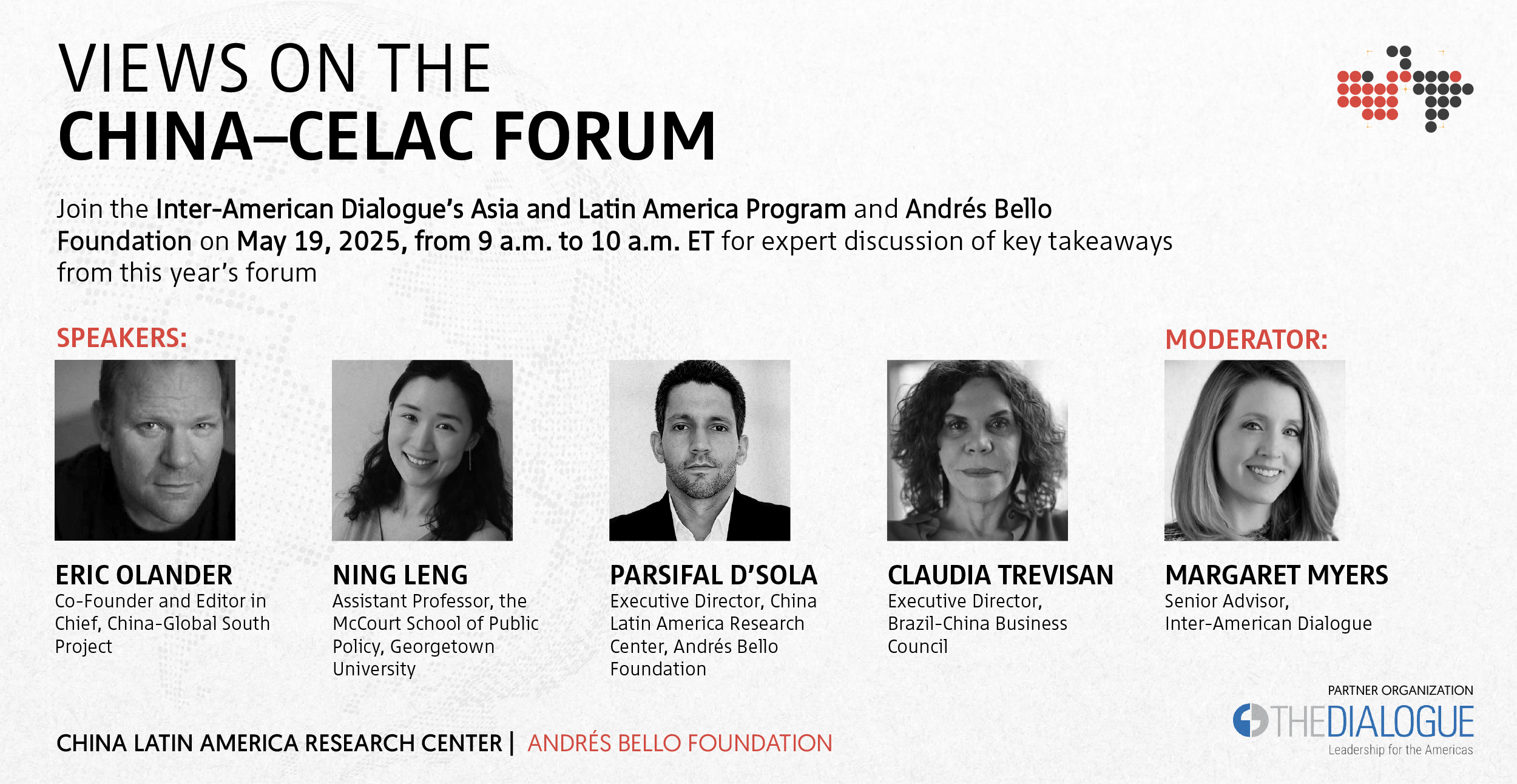Webinar | Views on the China–CELAC Forum 2024
Date: May 2024
Format: Virtual
Moderator: Margaret Myers (Inter-American Dialogue)
Panelists:
- Eric Olander (China-Global South Project)
- Ning Leng (Georgetown University)
- Parsifal D’Sola (China–Latin America Research Center, Andrés Bello Foundation)
- Claudia Trevisan (Brazil–China Business Council)
Event Summary
This virtual panel gathered leading experts to analyze the key messages, proposals, and omissions of the latest China–CELAC Forum. Although the forum was marked by ambitious rhetoric emphasizing South–South solidarity, the concrete commitments were limited compared to previous editions. The panelists offered complementary perspectives on how the China–Latin America relationship is evolving in light of the forum’s outcomes.
Key Themes
- Reduced Chinese Financial Commitments
China announced a USD 9 billion credit line, significantly lower than the USD 35 billion pledged in 2015. This reduction reflects both China’s current economic context and a strategic shift toward more selective bilateral engagement over broad regional packages. - Introduction of Panda Bonds
Panda Bonds—RMB-denominated bonds issued by foreign entities in China’s financial markets—represent a step in the country’s push to internationalize its currency. However, their accessibility and usefulness for Latin American countries remain uncertain, as these instruments shift financial risk to the issuers. - Mismatch Between Regional Expectations and Chinese Offers
There continues to be a disconnect between Latin American countries’ requests—such as for technological cooperation—and what China typically offers, namely infrastructure exports. Panelists emphasized the need for clearer and more realistic strategies from regional governments. - Soft Power and Cultural Projection
The forum reaffirmed China’s ongoing cultural diplomacy strategy, including academic exchanges, training programs for public officials, and the distribution of Chinese television content in Latin America. These initiatives are part of a sustained effort to strengthen ideological and cultural ties. - Strong Discourse, Few Tangible Agreements
Unlike other Chinese-led multilateral platforms, the China–CELAC Forum produced no bilateral agreements or major operational commitments. Panelists interpreted this as a sign of caution, driven by a sensitive global geopolitical environment and CELAC’s limited institutional capacity.
Moderator’s Key Questions and Panelist Insights
- Does the forum represent a new model for China–Latin America relations?
Panelists agreed that the forum reaffirmed existing patterns without introducing structural changes. China appears to be pursuing stable, low-cost relationships without taking on major financial risks. - What impact will the announced financing have?
There was skepticism about whether the USD 9 billion will be delivered, especially in the absence of specific recipients or sectors. - Are Panda Bonds a significant shift in the role of the renminbi?
While potentially contributing to RMB internationalization, their use in Latin America remains marginal. Some panelists argued the instruments benefit China more than the borrowers.
Audience Q&A Highlights
In the open Q&A session, panelists addressed questions on priority sectors, the role of the IDB, Argentina’s recent foreign policy shifts, and broader trends in China’s influence across the region:
- Which sectors are currently prioritized by China, in Latin America and beyond?
Claudia Trevisan noted strong Chinese interest in sectors such as energy, mining, and electric vehicles—both in Latin America and in other regions like Africa and Asia. However, she cautioned against overstating China’s expansion, emphasizing market-driven pragmatism over geopolitical ambition. - Is Chinese international financing overly concentrated in Chinese firms? What is the role of the IDB?
Parsifal D’Sola explained that Chinese loans—especially for infrastructure—often benefit Chinese contractors. This is less about coercion and more a reflection of China’s cooperation model, which ties financing to Chinese technology and firms. As for the Inter-American Development Bank, he noted that while it remains relevant, its influence is constrained by internal tensions and political pressures, especially when projects funded multilaterally benefit Chinese companies. - Does Argentina’s shift toward the U.S. under President Milei signal a retreat from China?
Ning Leng argued that while diplomatic rhetoric has cooled, the economic ties—especially in infrastructure and financing—remain intact. A recalibration, rather than a rupture, is more likely. Eric Olander added that political shifts in Latin America often affect tone more than long-term economic logic; China has proven adept at engaging with ideologically diverse governments. - Is China’s influence in Latin America growing or declining?
All panelists agreed that China’s influence is not in decline but has entered a phase of consolidation. Ning Leng noted that the rapid expansion seen in the 2010s has transitioned into a more strategic and stable stage. D’Sola emphasized that influence now includes institutional networks in areas such as technology and standards. Trevisan remarked that China has become a structural player in key sectors of the regional economy. Olander concluded that the challenge for Latin American countries is not whether China will remain present, but how to engage with Beijing in a more proactive and strategic way.
Conclusion
The 2024 China–CELAC Forum highlighted both the continuity and limitations of China’s engagement with Latin America. Despite the discourse around solidarity, cooperation, and multipolarity, the event delivered few concrete outcomes. The panelists agreed that the relationship has entered a mature phase where symbolic diplomacy often outweighs tangible commitments. Going forward, it will be crucial for Latin American countries to define clearer objectives and develop coherent strategies for navigating this structurally asymmetric but strategically important relationship.

